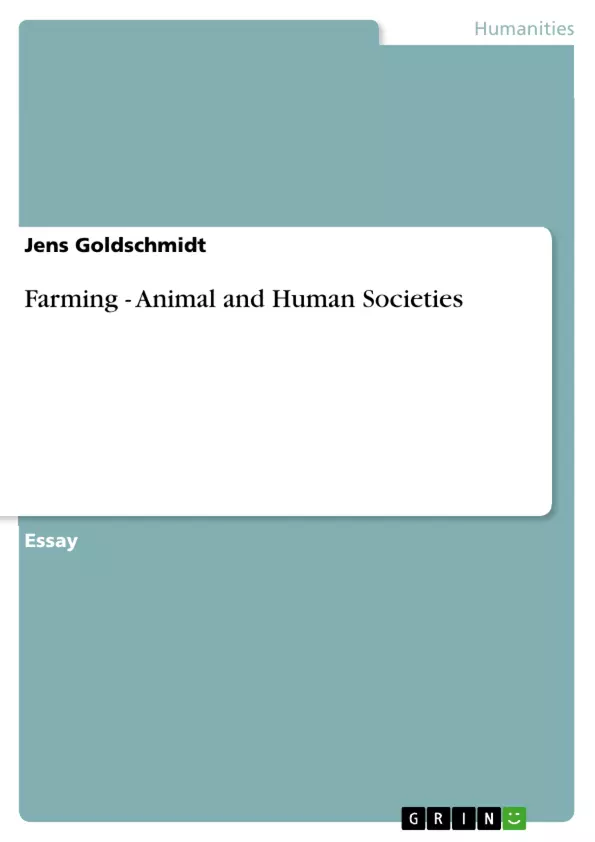The following essay is about farming and it consists of four parts. At first I will illustrate the processes that have taken place in the transition from family farming to industrial livestock farming. The second part will be about the economic advantages modern farming implies for humans and the negative influences it has on animals. Thirdly, I will introduce some measures that have been taken over the last few decades to reconcile the human benefits of such farming methods with the suffering they cause to animals.
Finally, I will show that some resulting compromises between commerce and the animal welfare movement have marked a step forward, but that there is still a lot to be done in order to enhance the life of farm animals.
Farm animals are being taken off the fields and the old lichen covered barns are being replaced by gawky, industrial type buildings into which the animals are put. [...] The sense of unity with [the farmer's] stock which characterizes the traditional farmer is condemned as being uneconomic and sentimental. [...] Factory farm
animals are assessed purely for their ability to convert food into flesh, or `saleable products'. (p. 1)
This is how Ruth Harrison (1964) describes the shift from traditional family farming to modern farming methods like industrial livestock farming. Having a closer look on this shift, one can see that in early modernity from about 1500 to 1800 farm animals were part of a farm's community. They lived much closer to their owners than nowadays, it was even common to live with ones animals
under the same roof in so called "long-houses". Furthermore, most farm animals were given names and some farmers knew their cattle so detailed, that they were able to identify them by their hoof prints (Thomas, 1983, p. 94).
Besides, animals served not only as food, but also as instruments for labour on the acre, and most farmers bred animals for personal consumption or for local markets (Thomas, 1983). This rather idyllic method of farming began dying out in the middle of the 19th
century, when the industrial revolution started in western Europe. [...]
Inhaltsverzeichnis (Table of Contents)
- Farming
- The transition from family farming to industrial livestock farming
- Economic advantages and negative influences on animals
- Measures to reconcile human benefits with animal suffering
- Compromises between commerce and animal welfare
Zielsetzung und Themenschwerpunkte (Objectives and Key Themes)
The essay examines the transformation of farming practices from traditional family farming to modern industrial livestock farming. It analyzes the economic benefits and negative consequences of this shift, specifically focusing on the welfare of farm animals.
- Transition from traditional family farming to industrial livestock farming
- Economic advantages of industrial livestock farming
- Negative consequences of industrial livestock farming on animal welfare
- Measures to mitigate animal suffering in industrial livestock farming
- The need for further improvements in animal welfare
Zusammenfassung der Kapitel (Chapter Summaries)
- The first chapter discusses the historical shift from traditional family farming to industrial livestock farming, highlighting the key drivers of this transformation, including urbanization and the industrial revolution.
- The second chapter explores the economic advantages of industrial livestock farming, such as increased efficiency, mechanization, and reduced labor costs. This chapter also provides examples from New Zealand's dairy industry to illustrate the impact of technological advancements.
- The third chapter focuses on the welfare issues associated with industrial livestock farming, such as restricted movement, mental disorders, disease risks, and transport stress. The chapter draws on various sources to illustrate the negative consequences of confinement systems and intensive farming practices.
- The fourth chapter examines measures taken to improve animal welfare in industrial livestock farming, including European Union legislation and other initiatives aimed at minimizing suffering and promoting better animal care.
Schlüsselwörter (Keywords)
The key terms and concepts in this essay include industrial livestock farming, animal welfare, traditional family farming, economic advantages, confinement systems, disease risks, transport stress, and measures to mitigate animal suffering.
- Quote paper
- Jens Goldschmidt (Author), 2009, Farming - Animal and Human Societies, Munich, GRIN Verlag, https://www.hausarbeiten.de/document/177054


